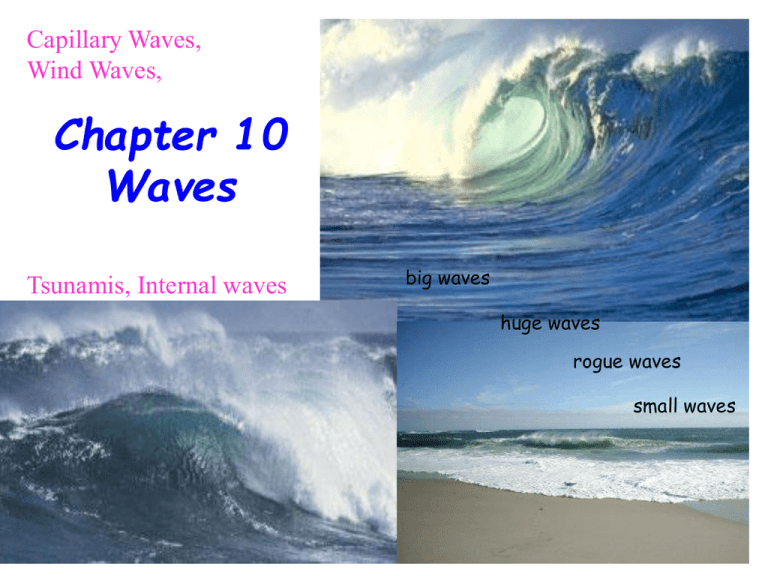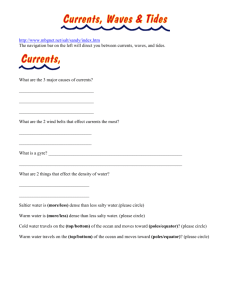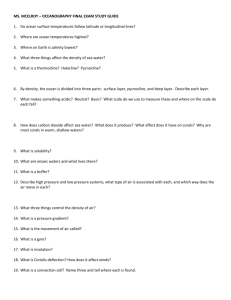Shallow-Water Waves
advertisement

Capillary Waves, Wind Waves, Chapter 10 Waves Tsunamis, Internal waves big waves huge waves rogue waves small waves Wave Wave direction wave energy – NOT the water particles – moves across the surface of the sea wave form moves and with it, energy is transmitted Direction of wave motion A B Wavelength Height Still water level Crest Frequency: Number of wave crests passing point A or point B each second Period: Time required for wave crest at point A to reach point B Trough Orbital path of individual water molecule at water surface Fig. 10-2, p. 266 Anatomy of a Wave more like a real wave more like a sine wave Parts of a Wave * Wavelength * height * Crest * trough * amplitude * Frequency - # of waves passing a fixed point in a given length of time * Period - time for successive crests or troughs (1 wavelength) to pass a fixed point Direction of wave motion Wave-length Crest 1/2 wavelength depth Trough Still water level Crest If we had this below, then there would be no net mass transport and no contribution of waves to the surface currents No mass transport Closed orbit after one period BUT in reality orbits are not exactly closed and waves DO contribute to mass transport Stokes drift (mass transport) Open orbit after one period How do a waves form? • Wind blowing across calm water – if gentle breeze capillary waves. Generating force = wind; restoring force = surface tension (cohesion); grow up to a wavelength of about 2 centimeters • As wind speed increases - wave becomes larger. Generating force = wind; restoring force changes from surface tension to gravity Types of waves - (1) progressive & (2) standing waves (1) progressive = have a speed and move in a direction • surface waves: deep-water & shallow-water waves • big’ waves: large swells, tsunamis & episodic waves • internal waves at the pycnocline (2) standing waves or seiches - do not progress, they are progressive waves reflected back on themselves and appear as alternating troughs and crests at a fixed position called antinodes, oscillating about a fixed point called node. They occur in ocean basins, enclosed bays and seas, harbors and in estuaries. Disturbing force Restoring force Gravity Amount of energy in ocean surface Period (& wavelength) and Wave Energy Tide Type of wave Seismic disruption landslides Wind Surface tension Gravity Tsunami Seiche Wind wave Capillary wave (ripple) 2412 hr.hr. 100,000 sec 10,000 sec 1,000 sec 100 sec 10 sec (1 1/4 days) (3 hr) (17 min) 1 sec 1/10 sec 1/100 sec 10 100 Period (time, in seconds for 1 two successive wave crests to Frequency (waves pass a fixed point) per second) Waves transmit energy across the ocean’s surface. Wave energy in the ocean as a function of the wave period. As the graph shows, most wave energy is typically concentrated in wind waves. However, large tsunami, rare events in the ocean, can transmit more energy than all wind waves for a brief time. Ides are waves – their energy is concentrated at periods of 12 and 24 hours. Deep- to Shallow-Water Waves Progressive waves. Classification depends on their wavelength relative to the depth of water through which they are passing. Note the importance of the relationship between wavelength and depth in determining wave type. Extra Credit Assignment - 12/05/2008 Write a 2-page essay on one of the following topics: 1. Rogue Waves 2. Tsunami Guidelines: 1. Select one of the two topics above. 2. Do some “research” on your topic, take notes, connect the information you gather to the material of this class, make sure you can explain your notes, and only then start writing your essay. An excellent place to begin research about your subject is a Google search. 3. Essay is due Friday Dec. 12, by the time of class (2:10 pm) - this is an ABSOLUTE deadline. Essay must be TYPED! Can be sent electronically to the class email address. Keep in mind the key ideas in chapter 10: • Waves transmit energy MOSTLY, not water mass, across the ocean's surface. • Most waves affect only the ocean’s surface layer. Movement ceases at a depth equal to about half the wave’s wavelength. • Arranged from short to long wavelengths (and therefore from slowest to fastest), ocean waves are generated by very small disturbances (capillary waves), wind (wind waves), rocking of water in enclosed spaces (seiches), seismic and volcanic activity or other sudden displacements (tsunami), and gravitational attraction (tides). Next: • The speed of ocean waves usually depends on their wavelength, with long waves moving fastest. • The behavior of a wave depends largely on the relation between the wave’s size and the depth of water through which it is moving. • Wind strength and duration determine the wavelength and speed of wind waves. Wave Speed – C Speed is equal to wavelength, L, divided by period, T. Example: the speed of a wave with a wavelength of 233 meters and a period of 12 seconds is 19.4 meters per second. The easiest wave characteristic to measure exactly is period Wave propagates with C – Energy moves with V Wave Speed is C - Group Speed is V wave speed = wavelength / period or C=L/T T is determined by generating force so it remain the same after the wave formed, but C changes. In general, the longer the wavelength the faster the wave energy will move through the water. Deep Water Waves * surface waves progressing in waters of D larger than 1/2 L * as the wave moves through, water particles move in circular orbit * diameter of orbits decrease with depth, orbits do not reach bottom, particles do not move below a depth D = L/2 Period of up to about 20 seconds Wavelength of up to at most 600 meters (extreme) Speed can be up to 100 km/hr (70 mi/hr) (extreme) * The wave speed can be calculated from knowing either the wavelength or the wave period: C = 1.56 m/s2 T or C2 = 1.56 m/s2 L Example: a 300 meters wave with a 14 sec period, propagates at 22 meters per second * Group Speed (which really transport the energy) is half of the wave speed for deep-water waves: V = C/2 Shallow-Water Waves • surface waves generated by wind and progressing in waters of D less than (1/20) L • wave motion: as the wave moves through, water particles move in elliptical orbits • diameter of orbits remains the same with depth, orbits do reach the bottom where they ‘flatten’ to just an oscillating motion back and forth along the bottom Period up to about 20 minutes Wavelength up to about 200 kilometers and more Speed up to about 750-800 km/hr (close to 500 mi/hr!!) * The wave speed and the wavelength are controlled by the depth D of the waters only: C gD 3.1 D Example: a 300 meters wave propagating in a 10 meterdeep channel has a speed of 9 meters per second * Group Speed (which transport the energy) is the same as the wave speed for shallow-water waves: V = C Wind Blowing over the Ocean Generates Waves Waves development and growth are affected by: Wind Speed: velocity at which the wind is blowing Fetch: distance over which the wind is blowing Duration: length of time wind blows over a given area Larger Swell Move Faster waves separate into groups wave separation is called dispersion Fetch: uninterrupted distance over which the wind blows without significant change in direction. Factors affecting wind wave development: Wind Speed, Fetch & Duration Wave size increases with increased wind speed, duration, and fetch. A strong wind must blow continuously in one direction for nearly three days for the largest waves to develop fully. Pacific Ocean: wind speed of 50 mi/hr, blowing steadily for about 42 hours over a region of size 800 miles will results in 8 meters waves – can get to 17 meter waves! (see Table 10.2) Interference Produces Irregular Wave Motions When waves meet up, they interfere with one another. Wave interference can be: Destructive interference – two waves that cancel each other out, resulting in reduced or no wave Constructive interference – additive interference that results in waves larger than the original waves Rogue waves - these freak waves occur due to interference and result in a wave crest higher than the theoretical maximum 1 2 a b Constructive interference (addition) Destructive interference (subtraction) Constructive interference (addition) Constructive and destructive interference. Two waves of different wavelength (different storms) overlapping, one in blue and one in green. The ‘blue wave’ has a slightly longer wavelength. (b) The waves will interfere with each other to form a composite wave with (1) a very large crests and troughs if the interfere CONSTRUCTIVELY, or (2) the two waves will destructively interfere, and the crests and troughs will be very small. Wave Height, Wavelength & Wave Steepness Typical ratio wave height to wavelength in open ocean = 1:7 = wave steepness – angle of the crest = 120° Exceed these conditions and wave will break at sea whitecaps 7 across 1 high 120° Wave Height is controlled by (1) wind speed, (2) wind duration and (3) fetch (= the distance over water that the wind blows in the same direction and waves are generated) Significant Wave Height - average wave height of the highest one-third of the waves measured over a long time Deep-water waves change to shallow-water waves as they approach the shore and they break 1 2 3 4 5 Depth = 1/2 wavelength Surf zone (1) The swell “feels” bottom when the water is shallower than half the wavelength. (2) The wave crests become peaked because the wave’s energy is packed into less water depth. (3) Water’s circular motion due to wave is constrained by interaction with the ocean floor and slows the wave, while waves behind it maintain their original rate. (4) The wave approaches the critical 1:7 ratio of a wave height to wavelength. (5) The wave breaks when the ratio of wave height to water depth is about 3:4. The movement of water particles is shown in red. Note the transition from a deep-water wave to a shallow-water wave. The Surf Zone - Breakers Wave Breaking: wave becomes unstable as water particles at the crest travel much faster/farther than water particles in the trough spiller plunger Breaker type is determined by slope, composition and contours of the bottom Breaker Types Tsunami • Vertical sea floor displacement • Shallow water waves Long wavelength Relatively long period (compared to wind waves) • Wave height changes (quite dramatically!) At point of origin Close to shore where depth decreases Landslides, Icebergs falling from glaciers, Volcanic eruptions, Asteroid impacts, Other direct displacements of the water surface CAN also generate tsunami Read sections 10.24 through 10.29 and review questions 24 through 30 (page 291 of current textbook) The great Indian Ocean tsunami of 26 December 2004 began when a rupture along a plate junction lifted the sea surface above. The wave moved outward at speeds of 212 meters per second (472 miles per hour). At this speed, it took only about 15 minutes to reach the nearest Sumatran coast and 28 minutes to travel to the city of Banda Ache. Tsunami Move at High Speed The speed of a tsunami can be calculated using the same formula used for other shallow-water waves: __ C = gd g = 9.8 meters per second (the acceleration due to gravity) d = depth (a typical Pacific abyssal depth is 4,600 meters) Eleven destructive tsunami have claimed more than 180,000 lives since 1990. Cartoon Illustration Tsunamis become dangerous only near shore More Key ideas to keep in mind: • Waves can interfere with one another, resulting in larger or smaller waves. • Most waves change shape and speed as they approach shore. They may plunge of spill at the surf zone and bend to break nearly parallel to shore. • A storm surge is a short-lived, abrupt bulge of water driven on shore by a tropical cyclone or a frontal storm (from Ch. 8). Although storm surges are sometimes called storm tides or storm waves, storm surges consist of only a crest, so they cannot be assigned a period or wavelength, and cannot be called a wave. • Tsunami are always shallow-water waves. No ocean basin is deeper than one-half their wavelength. Tsunami have been responsible for large losses of life and property. • Tsunami are caused when water is displaced by the forces that cause earthquakes or by landslides, eruptions, or asteroid impacts. Typically tsunami resemble a fast-onrushing tide, not a breaking wave. They are not dangerous in the open sea. And there is more: Even greater waves exist: the tides. Yes, two “tidal waves” move along most coasts each day; the crests are the day’s high tides; and the troughs, the day’s low tides. Tides are shallow-water waves no matter how deep the ocean they’re moving through. Tides can be destructive, but among all waves their ability to cause damage is fortunately not proportional to their wavelengths. Review 1. Wavelength Is the Most Useful Measure of Wave Size 2. The Behavior of Waves Is Influenced by the Depth of Water through Which They Are Moving 3. Wind Blowing over the Ocean Generates Waves – we call these ‘wind waves’ 4. Storm Surges are NOT waves 5. Tsunami are long-wavelength, shallow-water, progressive waves Caused by Water Displacement 6. Tsunami Are Always Shallow-Water Waves Chapter 11 – Tides A tidal bore is formed when a tide arrives to an enclosed river mouth. This is a forced wave that breaks. Tidal range can be very large Tide - rhythmic oscillation of the ocean surface due to gravitational & centrifugal forces (‘inertia’) between the Earth, Moon and Sun. Tide Patterns - regular, cyclic patterns of low water-high water Tidal cycle – one low tide and one high tide consecutively diurnal tide - one low tide, one high tide a day; semidiurnal tide - high water-low water sequence twice a day; 2 high, 2 low, about the same level semidiurnal mixed tide - same as semidiurnal but 2 highs and 2 lows do not reach/drop to the same level; may be the result of a combination of tide types Tide Patterns - regular, cyclic patterns of low water-high water diurnal tide semidiurnal tide semidiurnal mixed tide Semidiurnal tides Diurnal tides Mixed tides Most of the world’s ocean coasts have semidiurnal tides. d (ft) 14 10 6 4 0 –4 Mixed tide, Los Angeles Diurnal tide, Mobile, Alabama Semidiurnal tide, Cape Cod Higher high tide High tide Lower high tide High tide Lower low tide Higher low tide (m) 4 3 2 1 0 –1 Low tide Low tide 0 612 18 24 30 36 42 48 0 6 12 18 24 30 36 42 48 0 6 12 18 24 30 36 42 48 a Time (hr) b Time (hr) c Time (hr) Flood Tide: tide wave is propagating (onto shore) onshore – water level is rising High Tide: water level reaches highest point Ebb Tide: tide is moving out to sea – water level is dropping Low Tide: water level reaches lowest point Slack tide: period when tide wave is reversing – low current velocity Water currents are generated by the tides, the speed of the incoming tide is about the same but in the opposite direction of the outgoing tide. Moving waters have to slow down and reverse, from flood to ebb and vice versa (slack tide). This is a good time for navigation through narrow places, particularly those characterized by strong tides (East River, for example). Tides Are the Longest of All Ocean Waves Characteristics and Causes of tides: Tides are caused by the gravitational force of the moon and sun and the motion of earth. The wavelength of tides can be half the circumference of earth. Tides are the longest of all waves. Tides are forced waves because they are never free of the forces that cause them. Study of Tides: Equilibrium Tidal Theory - ideal approach to understand basic principles, assumes an earth covered with water and an infinitely deep basin. Dynamical Tidal Analysis - realistic approach, studying the tides as they occur on earth, accounts for modification due to landmasses, geometry of ocean basins, earth’s rotation. Chapter 11 – Summary Tides are huge shallow-water waves-the largest waves in the ocean. Tides are caused by a combination of the gravitational force of the moon and sun and the motion of Earth. The moon's influence on tides is about twice that of the sun's. The equilibrium theory of tides deals primarily with the position and attraction of the Earth, moon, and sun. It assumes that the ocean conforms instantly to the forces that affect the position of its surface, and only approximately predicts the behavior of the tides. The dynamic theory of tides takes into account the speed of the longwavelength tide wave in water of varying depth, the presence of interfering continents, and the circular movement or rhythmic backand-forth rocking of water in ocean basins. It predicts the behavior of the tides more accurately than the equilibrium theory. These huge shallow-water waves are forced waves: never free of the forces that cause them and so act in unusual but generally predictable ways.





